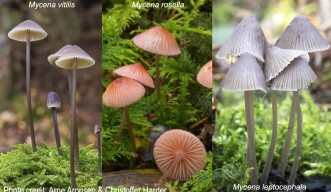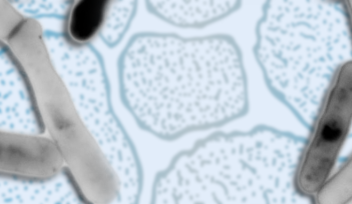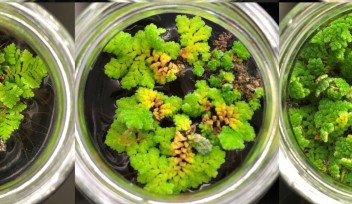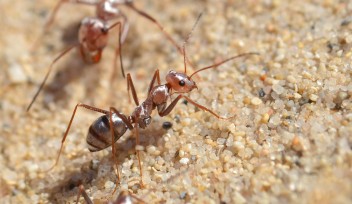Mushrooms with “massively expanded” genomes make them more adaptable to multiple lifestyles
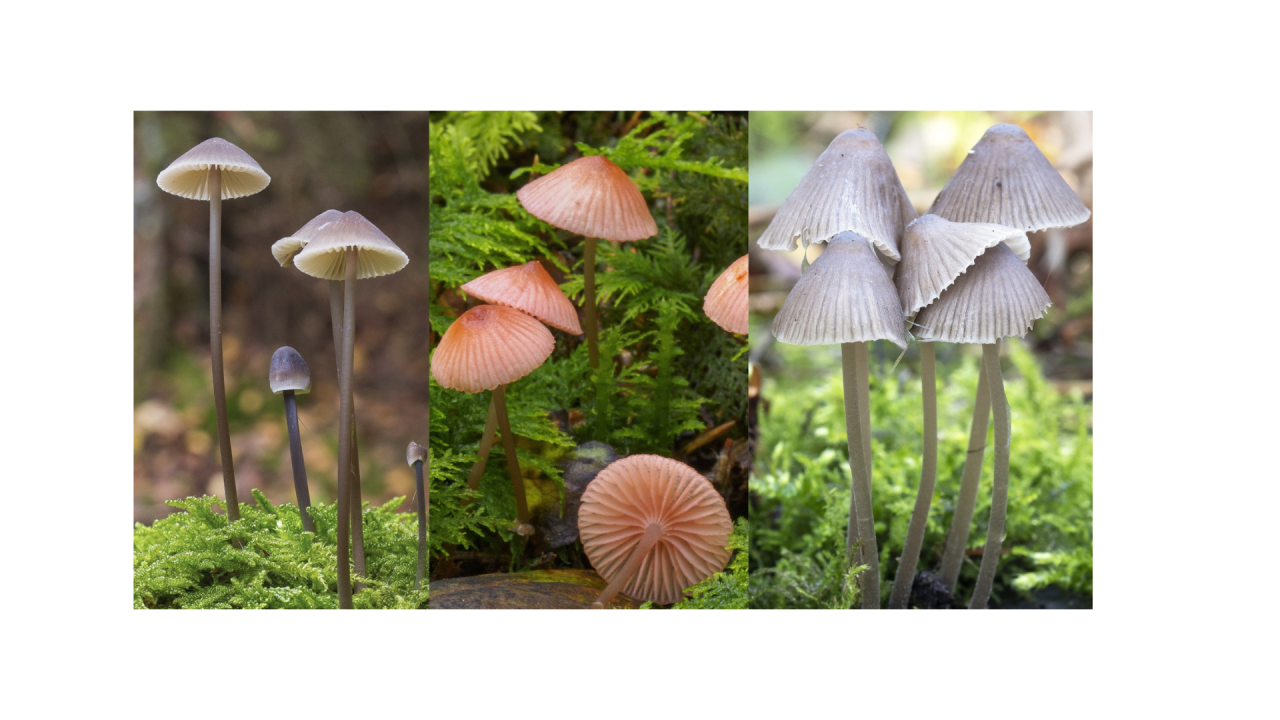
This article is based on a press release published by Cell Press and amended by OIST science writer Merle Naidoo
A study of multiple Mycena mushroom species reported in the journal Cell Genomics has found that they have unexpectedly large genomes. While the mushrooms had been thought to be purely saprotrophic – living by degrading dead organic material alone – the discovery suggests that they may instead have a collection of genes to enable them to adapt to different lifestyles as circumstances change. Interestingly, they show certain Mycena strains living in the Arctic have some of the largest mushroom genomes ever described.
These mushrooms show widespread growth across their genome. This includes not only the genes that help them invade or interact with plants and break down carbon, but also genes whose functions are not yet known but are likely important. Additionally, there are many repetitive, non-coding elements and genes that they have acquired from other, unrelated fungi through horizontal gene transfer.
“The Mycena samples were collected in Northern Europe, and one of our collaborators gathered samples from the Arctic area. Three of these were successfully sequenced, and we found that these Arctic species contained significantly larger genomes compared to ordinary Mycena species,” explained Dr. Shingo Miyauchi, co-lead author at the Okinawa Institute of Science and Technology (OIST)’s Evolutionary and Synthetic Biology Unit. “My initial impression was that this is not normal, so we contacted our collaborators who verified the genome assembly’s correctness. We then concluded that these highly expanded genomes were unique to certain Arctic Mycena species.”

“Evolution tells us that non-advantageous traits tend to disappear over time, so an obvious implication is that adaptability and generalism in those large genome structures must be an advantage for these fungi,” added Francis Martin of the INRAE (French National Research Institute for Agriculture, Food and Environment) and the University of Lorraine in Champenoux, France. “This is despite the costs of having a large genome with lots of possibly unnecessary features that must be replicated in each cell division. This may be particularly true in an extreme environment like the Arctic, as also seen in plants.”
The researchers set out to study Mycena based on their role as a main mushroom decomposer of litter and leaves in forest ecosystems. Despite their tiny fruiting bodies, Mycena have an important role in the global carbon cycle. This group of mushrooms had long been thought to live purely on dead organic material, but more recently it was found that some species also make a living through cooperative or parasitic interactions with living plants.
Mycenas are also bioluminescent – i.e. they glow in the dark – and earlier work describing the genomes of five Mycena species had investigated this phenomenon. To learn more about their direct lifestyle habits, the researchers now wanted to study a broad palette of Mycena species with different preferences for substrates.
In the new study, they generated new genome sequences for 24 additional Mycena species and a related species now known as Atheniella floridula. The species included represent six decayer categories: wood generalists, broadleaf wood decayers, grass litter generalists, broadleaf litter decayers, coniferous litter decayers, and overall litter generalists. It also included three Arctic species. They added their new genomes to 33 additional genomes from non-Mycena species. They wanted to understand how the genomes had evolved and expanded over evolutionary time and how species might differ in plant cell wall-degrading enzymes based on their lifestyle habits.
They were surprised to find that Mycena showed massive genome expansions overall, affecting all gene families regardless of their expected habits. The expansion appeared to be driven by the emergence of novel genes as well as gene duplications, enlarged collections of genes that produce enzymes for degrading polysaccharides, the proliferation of transposable elements, and horizontal gene transfers from other fungal species. They also found that two species collected in the Arctic had the largest genomes by far, at a size that is two to eight times bigger than Mycena living in temperate zones.
The researchers were particularly surprised to find that the genomes of the Arctic species expanded significantly beyond the general Mycena expansion. Additionally, they discovered that Mycena fungi had acquired genes from Ascomycetes through horizontal gene transfer. These species are also found in temperate regions, but it remains unclear whether their large size is due to specific species characteristics or an effect related to the Arctic environment.
However, some Arctic plants have been shown to inflate their genomes with transposable elements, or simply duplicate their entire genomes altogether compared to their close relatives in temperate areas, and it is of course tempting to suggest that a similar parallel evolution could be happening in Arctic mushrooms.
“The evolutionary transition from decomposer to symbiotic fungi is generally believed to have happened in parallel in several fungal groups throughout the course of evolution millions of years ago,” says Håvard Kauserud of the University of Oslo, Norway. “However, with Mycena, we appear to be seeing this gradual process in action happening right in front of our eyes.”
“We know from other lines of research that Mycena, contrary to many other fungi, can adopt more than one possible lifestyle. The findings suggest that these multiple possible lifestyles are reflected in their genome structures, too”, said Christoffer Bugge Harder, co-lead author at the University of Oslo.
The findings also have important implications for efforts to understand an organism’s habits from their genome sequences alone.
As a data scientist with a strong interest in visual art, Dr. Miyauchi enjoys being creative with data visualization. “I spent two years comparing fungal genome features for this study and was inspired by the colors of these tiny mushrooms. The figures I created were influenced by the 19th century French impressionist, Pierre-Auguste Renoir," he said.
He is currently working on a project sequencing genomes of rare deep-sea fungi which differ significantly from forest fungi. “Our goal is genome mining to uncover unusual genes, enzymes, and metabolites. Ultimately, we aim to isolate unique genomic materials for biotechnological applications. It’s my hope that funding bodies recognize the huge future potential of petite mushrooms.”

This article is based on a press release published by Cell Press and amended by OIST science writer Merle Naidoo
Article Information
Specialties
Research Unit
For press enquiries:
Press Inquiry Form











